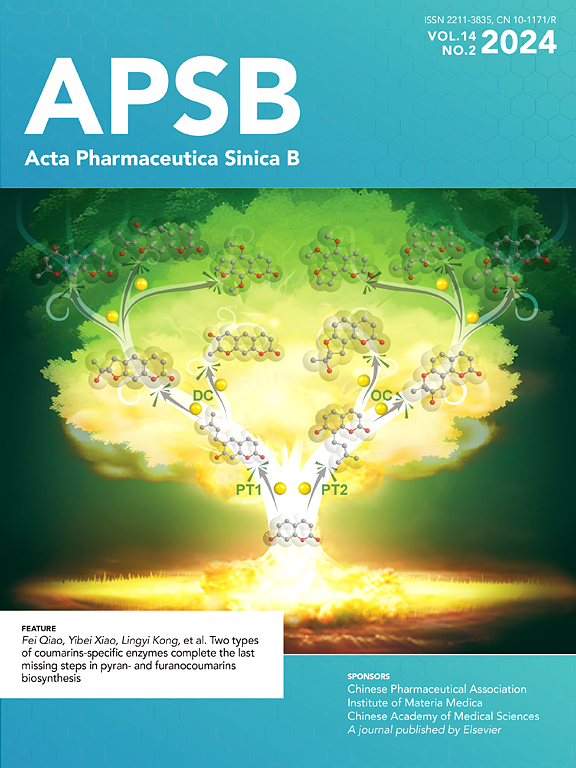RXRα通过靶向CaMKKβ-AMPKα轴调控肝星状细胞活化和肝纤维化
IF 14.7
1区 医学
Q1 PHARMACOLOGY & PHARMACY
引用次数: 0
摘要
肝星状细胞(Hepatic stellate cells, hsc)是肝脏中主要的纤维化细胞,其活化在肝纤维化的发生和发展中起着至关重要的作用。在这里,我们报道了类视黄醛X受体α (RXRα),核受体超家族的独特成员,是HSC激活和肝纤维化的关键调节剂。RXRα通过调节钙/钙调素依赖性蛋白激酶激酶β (CaMKKβ)介导的amp活化蛋白激酶α (AMPKα)的活化发挥作用。此外,我们发现K-80003通过一种独特的机制结合RXRα,有效抑制HSC的激活、增殖和迁移,从而抑制CCl4和amylin肝NASH (AMLN)饮食动物模型中的肝纤维化。这种作用是通过激活AMPKα介导的,促进造血干细胞的有丝分裂。机制上,K-80003通过诱导RXRα与CaMKKβ和AMPKα形成凝聚体,通过两相过程激活AMPKα。RXRα凝聚体的形成是由其n端内在无序区驱动的,需要CaMKKβ磷酸化。我们的研究结果揭示了RXRα通过调节造血干细胞的线粒体活性在肝纤维化调节中的关键作用。此外,他们认为K-80003和相关的RXRα调节剂有望作为纤维化相关疾病的治疗剂。本文章由计算机程序翻译,如有差异,请以英文原文为准。

RXRα modulates hepatic stellate cell activation and liver fibrosis by targeting CaMKKβ–AMPKα axis
Hepatic stellate cells (HSCs) are the primary fibrogenic cells in the liver, and their activation plays a crucial role in the development and progression of hepatic fibrosis. Here, we report that retinoid X receptor-alpha (RXRα), a unique member of the nuclear receptor superfamily, is a key modulator of HSC activation and liver fibrosis. RXRα exerts its effects by modulating calcium/calmodulin-dependent protein kinase kinase β (CaMKKβ)-mediated activation of AMP-activated protein kinase-alpha (AMPKα). In addition, we demonstrate that K-80003, which binds RXRα by a unique mechanism, effectively suppresses HSC activation, proliferation, and migration, thereby inhibiting liver fibrosis in the CCl4 and amylin liver NASH (AMLN) diet animal models. The effect is mediated by AMPKα activation, promoting mitophagy in HSCs. Mechanistically, K-80003 activates AMPKα by inducing RXRα to form condensates with CaMKKβ and AMPKα via a two-phase process. The formation of RXRα condensates is driven by its N-terminal intrinsic disorder region and requires phosphorylation by CaMKKβ. Our results reveal a crucial role of RXRα in liver fibrosis regulation through modulating mitochondrial activities in HSCs. Furthermore, they suggest that K-80003 and related RXRα modulators hold promise as therapeutic agents for fibrosis-related diseases.
求助全文
通过发布文献求助,成功后即可免费获取论文全文。
去求助
来源期刊

Acta Pharmaceutica Sinica. B
Pharmacology, Toxicology and Pharmaceutics-General Pharmacology, Toxicology and Pharmaceutics
CiteScore
22.40
自引率
5.50%
发文量
1051
审稿时长
19 weeks
期刊介绍:
The Journal of the Institute of Materia Medica, Chinese Academy of Medical Sciences, and the Chinese Pharmaceutical Association oversees the peer review process for Acta Pharmaceutica Sinica. B (APSB).
Published monthly in English, APSB is dedicated to disseminating significant original research articles, rapid communications, and high-quality reviews that highlight recent advances across various pharmaceutical sciences domains. These encompass pharmacology, pharmaceutics, medicinal chemistry, natural products, pharmacognosy, pharmaceutical analysis, and pharmacokinetics.
A part of the Acta Pharmaceutica Sinica series, established in 1953 and indexed in prominent databases like Chemical Abstracts, Index Medicus, SciFinder Scholar, Biological Abstracts, International Pharmaceutical Abstracts, Cambridge Scientific Abstracts, and Current Bibliography on Science and Technology, APSB is sponsored by the Institute of Materia Medica, Chinese Academy of Medical Sciences, and the Chinese Pharmaceutical Association. Its production and hosting are facilitated by Elsevier B.V. This collaborative effort ensures APSB's commitment to delivering valuable contributions to the pharmaceutical sciences community.
 求助内容:
求助内容: 应助结果提醒方式:
应助结果提醒方式:


